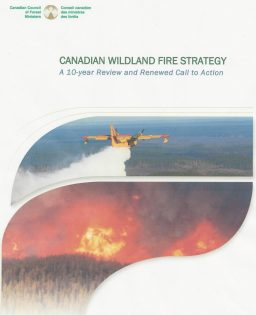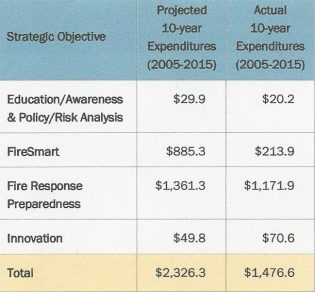Call for Renewed Commitment to Wildfire Strategy
Prince George, B.C- It’s been eleven years since the Canadian Wildland Fire Strategy 
(click on image at right to access full report)
The review, prepared on behalf of the Wildland Fire Management Working Group of the Canadian Council of Forest Ministers, notes the challenges first identified just over a decade ago, remain, and if anything, are increasing.
According to the report, making progress on the strategy “has been slower and more costly than originally envisioned.” When first developed in 2005, the strategy estimated it would need an investment of $2.3 billion dollars, but there was “no formal agreement established for sharing the costs associated with its execution, the expectation was that the federal as well as all provincial and territorial governments would contribute.”
( at right, the objectives and projected vs. actual expenditures as outlined in the report. Dollar figures are in millions.- image courtesy Canadian Wildland Fire Strategy)
While tracking the actual dollars dedicated to the 2005 strategy is difficult, the report indicates the only area in which the projected investment has been met is in the area of innovation, which includes the development of smoke forecasting systems and the enhancement of the forest fire danger rating system,
The original strategy identified climate change and labour as major challenges.
Climate change is resulting in :
- decreasing water availability,
- increasing arid conditions and
- shifting of vegetation to more drought-resistant trees and grasslands that are more fire prone.
As for labour, the report indicates it is becoming more difficult to find those who want to work in the field of wildland fire management. The report says “the declining availability of qualified individuals is driving an increasing reliance on retired firefighters, contractors and municipal or local fire departments.” There is also a concern of stress on workers who are facing longer fire seasons.
While the costs associated with wildland fires are usually limited to the costs for suppression, the report says that is just the tip of the iceberg. Other costs include loss of merchantable timber, damage to private property and public infrastructure, the costs associated with evacuation of communities, and those associated with the loss of economic activity.
“Wildfire is not only a forestry issue” writes B.C. Minister of Forests Steve Thomson, “How we prevent wildfires and respond to wildfires is a significant public-safety, public health, First Nation, community and climate -change issue. Better collaboration is needed between federal agencies and between provinces, territories and the federal government.”
The report calls for increased investment in innovation, enhanced prevention and mitigation , enhance the commitment to making communities FireSmart and increase the infrastructure and labour component needed to fight fires.


Comments
Comments for this article are closed.